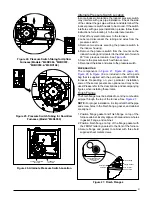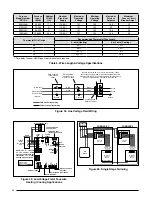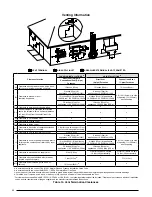
33
START-UP & ADJUSTMENTS
Pre-Start Check List
√
Verify the polarity of the connections are correct, the
line voltage power leads are securely connected and
the furnace is properly grounded.
√
Verify the thermostat wires (R, W, Y, & G) are securely
connected to the correct leads on the terminal strip of
the circuit board.
√
Verify the gas line service pressure does not exceed 10.0
inches of W.C., and is not less than 4.5 inches W.C. for
natural gas. For LP gas the line service pressure must
not exceed 14 in. W.C., and must not be less than 11.0
in. W.C.
√
Verify the roll-out and manual reset switch is closed. If
necessary, press the red button to reset a switch. DO
NOT install a jumper wire across a switch to defeat its
function. If a switch reopens on startup, DO NOT reset
the switch without identifying and correcting the
fault condition
.
√
Verify the blower door is in place, closing the door switch
in the line voltage circuit.
√
Verify the gas line has been purged and all connections
are leak free.
Start-up Procedures
Do not perform these steps until all of the checks in the
previous steps have been completed:
1. Set the thermostat to the lowest setting.
2. Turn off all electrical power to the furnace.
3. Follow the Operating Instructions on the label attached
to the furnace.
4. Set the thermostat above room temperature and verify
the Operating Sequence (
5. After 5 minutes of operation, set the thermostat below
room temperature and verify steps 9 & 10 of the
Operating Sequence.
one stage of heating and the second furnace to ignite
for the second stage of heating.
3. Refer to
thermostat connections. The C connection must be
made between the twinned furnaces to ensure proper
performance.
Grounding
WARNING:
To minimize personal injury, the furnace cabinet
must have an uninterrupted or unbroken
electrical ground. The controls used in this
furnace require an earth ground to operate
properly. Acceptable methods include electrical
wire or conduit approved for ground service.
Do not use gas piping as an electrical ground!
Example:
• Time for 1 revolution of a gas meter with a 1 cubic
ft dial = 40 seconds.
• From
• Local heating value of the gas (obtained from gas
supplier) = 1,040 Btu per cubic ft.
• Input rate = 1,040 x 90 = 93,600 Btuh.
Verifying & Adjusting Input Rate
IMPORTANT NOTE:
The input rate must not exceed the rate shown on the
furnace rating plate. At altitudes above 2,000 feet, it
must not exceed that on the rating plate less 4% for
each 1,000 feet.
The input rate must be verified for each installation to
prevent over-firing of the furnace. To determine the exact
input rate, perform the following procedures:
1. Shut off all other gas fired appliances.
2. Start the furnace and run it for at least 3 minutes.
3. Measure the time (in seconds) required for the gas
meter to complete one revolution.
4. Convert the time per revolution to cubic feet of gas per
.
5. Multiply the gas flow rate in cubic ft per hr by the heating
value of the gas in Btu per cubic ft to obtain the input
rate in Btuh. See example.
6. The manifold pressure must be set to the appropriate
value for each installation by a qualified installer, service
agency or the gas supplier. See
Verifying & Adjusting Temperature Rise
Confirm the temperature rise through the furnace is
within the limits specified on the furnace rating plate. Any
temperature rise outside the specified limits could result
in premature failure of the heat exchanger.
1. Place thermometers in the return and supply air stream
as close to the furnace as possible. The thermometer on
the supply air side must be shielded from direct radiation
from the heat exchanger to avoid false readings.
2. Adjust all registers and duct dampers to the desired
position and run the furnace for 10 to 15 minutes before
taking any temperature readings. The temperature rise
is the difference between the supply and return air
temperatures.
For typical duct systems, the temperature rise will fall
within the limits specified on the rating plate with the
blower speed at the factory recommended setting. If the
measured temperature rise is outside the specified limits,
it may be necessary to change the speed of the blower.
NOTE: Lowering the blower speed will increase the
temperature rise and a higher blower speed will decrease
the temperature rise.
The furnace is equipped with a multi-speed motor. Heating
and cooling speed selection is made by moving the switch
on the integrated control inside of the furnace.
Summary of Contents for M4RC-072D-35C
Page 47: ...47...













































